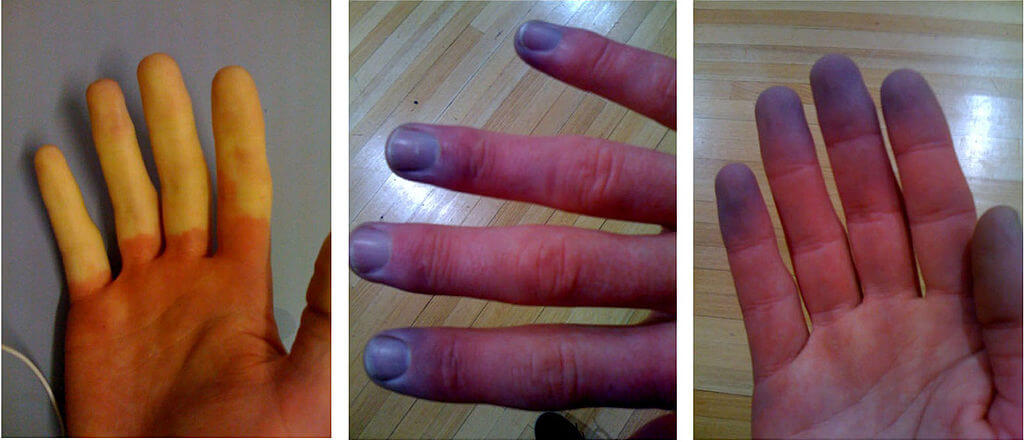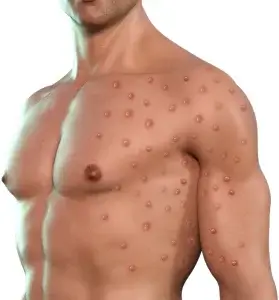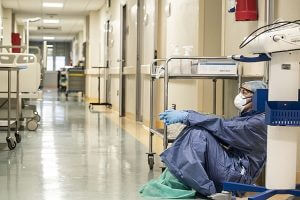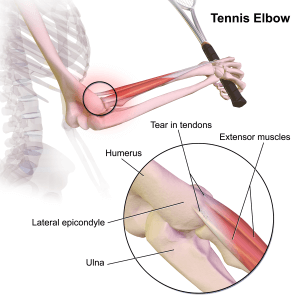Overview
Raynaud’s (ray-NOSE) syndrome also known as the Raynaud’s phenomenon is a condition in which there is numbness and decreased blood flow to some parts of your body, especially to your fingers and toes, due to cold temperatures, stress, or emotional upsets. Raynaud’s seems to affects 3-5 % of the general population. It appears to be more prevalent in people living in colder climates.
In this article, we will learn about the presentation, features, and treatment of Raynaud’s phenomenon, and provide a few tips on how to prevent it.

Signs and Symptoms
The sign and symptoms of Raynaud’s syndrome can vary in people. The most common symptoms include:
- Colour changes in your fingers or toes in response to cold or stress
- A feeling of fingers or toes getting cold (due to low blood flow)
- Numbness alongside prickly feeling or pricking pain upon relief
- Swelling of hands, developing sores and even gangrene (death) of tissue can occur in rare and untreated Raynaud’s – especially secondary Raynaud’s Phenomenon
As mentioned above Raynaud’s can present in any part of the body, however, it mostly affects the extremities due to the already lower blood flow. To name a few, it can also affect your nose, lips, ears, and even nipples.
Causes and Risk Factors
Causes
The causes of Raynaud’s attacks are not completely understood in the medical literature. It can be attributed to hands and feet overreacting to cold or stressful stimuli. In most cases there is vasospasm (constriction of blood vessels) in the arteries to the hand and feet leading to hypoperfusion – low blood flow.
Raynaud’s can be classified into:
- Primary Raynaud’s – occurring without any obvious causes. It is also known as Raynaud’s disease and is not associated with another disease.
- Secondary Raynaud’s – also called the Raynaud’s phenomenon. happens as a symptom of other underlying conditions like injuries, diseases (e.g., rheumatic fever), or from medicines. It is fairly less common than the primary form.
Some causes of Raynaud’s phenomenon include:
- Connective tissue disease – rare diseases like SLE (systemic lupus erythematosus), rheumatoid arthritis, etc.
- Arterial disorders – any condition affecting the arteries e.g., chronic hypertension (high blood pressure)
- Injuries involving hands and feet
- Carpal tunnel syndrome – a condition involving narrowing of the wrist
- Smoking
- Certain drugs – including drugs for controlling hypertension and migraine medication
Risk Factors
Risk factors for Primary Raynaud’s include:
- Sex – females are more prone to be affected
- Age – Raynaud’s usually affects people from 15-30 years of age, however, it can occur at any age
- Climate – Colder climate tends to trigger this condition
- Family History – first degree relatives i.e., a parent, sibling, or child, having the disease appears to increases the risks of having Raynaud’s
People having the following can have an increased risk of Secondary Raynaud’s:
- Associated Diseases – lupus or scleroderma
- Occupation – jobs inducing repetitive trauma, such as operative tools, riding a bike for too long, typing continuously, etc.
- Age – older than 30 years
- Smoking
Complications
Rarely, Raynaud’s phenomenon can become severe, and the severely decreased blood can precipitate tissue damage leading to tissue necrosis (cell death). Complete blockage of the artery can lead to sores (skin ulcers) which are usually hard to treat. In untreated cases, it can lead to tissue death and amputation (cutting off the dead part of the body).
Diagnosis
The diagnosis of Raynaud’s syndrome depends on a clinical history of symptoms and clinical examination by your doctor. Your doctor will test you differently i.e., putting your hands or feet in ice-cold water and looking for any discolouration or bluing of the fingers or toes along with the time it takes for hands and feet to come back to the normal temperature.
Microscopic examination can be done to check the condition of the vessels supplying your hands and feet – determining whether they are normal or constricted. A blood test or assays can help find the type of Raynaud’s i.e., is it primary or secondary. Underlying causes such as autoimmune (self-destructing) disease can be figured out.
Treatment
As for a lot of other diseases, the treatment of Raynaud’s will depend on your symptoms, age, and overall health. The severity of the condition also determines the type and intensity of treatment. Due to a lack of knowledge of the pathophysiology (mechanism) behind this disease, there is no cure yet. However, it can be well managed with adequate treatment.
If you are having a Raynaud’s attack you can reduce the severity and length of it by warming the affected areas. You can:
- Rub your hands and feet
- Tuck your hands in your armpits or under your thighs
- Place your hands in warm running water (not hot)
- If you’re excessively stressed, try to relax too simultaneously
For secondary Raynaud’s, you should avoid or treat the triggers that cause it. For instance:
- Avoid vibrating or drilling tools
- Avoid typing excessively
- Treatment of the underlying problems i.e., autoimmune diseases or injuries
Medications can also be used in the symptomatic treatment of Raynaud’s. these medicines will depend on the type, severity, and history of your Raynaud’s disease. You might be prescribed:
- Calcium channel blockers – these drugs relax the smooth muscles in your arteries, dilating (widening) them, and simply increasing the blood flow to the affected areas. Examples include nifedipine, amlodipine, etc.
- Vasodilators – these drugs also relax the blood vessels and increase blood flow. Some of the vasodilators prescribed include nitroglycerin cream, etc.
If you have severe Raynaud’s, you might be prescribed surgery or chemical injections that will alleviate your pain effectively.
Prevention
You can prevent the attacks of Raynaud’s by a couple of methods:
- Keep your hands and feet covered with extra layers to avoid exposure to cold
- Start the engine of your car early so it heats up on a cold day
- Keep gloves with you in case you need them
- Avoid physical jobs that require a lot of hand or finger movements
- Wear gloves while touching cold things, e.g., frozen items, etc.
- American College of Rheumatology: “Raynaud’s Phenomenon,” “Scleroderma.”
- Mayo Clinic: “Raynaud’s disease.”
- Johns Hopkins Medicine: “Raynaud’s Phenomenon.”
- National Heart, Lung, and Blood Institute: “Raynaud’s.”
- National Institute of Arthritis and Musculoskeletal and Skin Diseases: “Raynaud’s Phenomenon.”
- Archives of Internal Medicine: “Raynaud’s phenomenon and thyroid deficiency.”
- National Cancer Institute: “Vinyl Chloride.”
- Wigley FM. Clinical manifestations and diagnosis of the Raynaud phenomenon. https://www.uptodate.com/contents/search. Accessed Oct. 19, 2020.
- What is Raynaud’s phenomenon? National Institute of Arthritis and Musculoskeletal and Skin Diseases. https://www.niams.nih.gov/Health_Info/Raynauds_Phenomenon/raynauds_ff.asp. Accessed Oct. 19, 2020.
- Wigley FM. Treatment of the Raynaud phenomenon: Initial management. https://www.uptodate.com/contents/search. Accessed Oct. 19, 2020.
- Pauling JD, et al. Raynaud’s phenomenon — An update on diagnosis, classification and management. Clinical Rheumatology. 2019; doi:10.1007/s10067-019-04745.
- Raynaud’s. National Heart, Lung, and Blood Institute. https://www.nhlbi.nih.gov/health/health-topics/topics/Raynaud. Accessed Oct. 19, 2020.
- James WD, et al. Cutaneous vascular diseases. In: Andrews’ Diseases of the Skin: Clinical Dermatology. 13th ed. Elsevier; 2020. https://www.clinicalkey.com. Accessed Oct. 20, 2020.
- Pizzorono JE, et al., eds. Textbook of Natural Medicine. 5th ed. Elsevier; 2021. https://www.clinicalkey.com. Accessed Oct. 20, 2020.
- Epidemiology of Raynaud’s Phenomenon.
Authors: Adam Maundrell, Susanna M. Proudman
The content shared in the Health Literacy Hub website is provided for informational purposes only and it is not intended to replace advice, diagnosis, or treatment offered by qualified medical professionals in your State or Country. Readers are encouraged to confirm the information provided with other sources, and to seek the advice of a qualified medical practitioner with any question they may have regarding their health. The Health Literacy Hub is not liable for any direct or indirect consequence arising from the application of the material provided.



